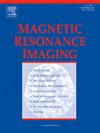End-to-End Deep Learning-Based Motion Correction and Reconstruction for Accelerated Whole-Heart Joint T1/T2 Mapping
IF 2
4区 医学
Q2 RADIOLOGY, NUCLEAR MEDICINE & MEDICAL IMAGING
引用次数: 0
Abstract
Purpose
To accelerate 3D whole-heart joint T1/T2 mapping for myocardial tissue characterization using an end-to-end deep learning algorithm for joint motion estimation and model-based motion-corrected reconstruction of multi-contrast undersampled data.
Methods
A free-breathing high-resolution motion-compensated 3D joint T1/T2 water/fat sequence is employed. The sequence consists of the acquisition of four interleaved volumes with 2-echo encoding, resulting in eight volumes with different contrasts. An end-to-end non-rigid motion-corrected reconstruction network is used to estimate high quality motion-corrected reconstructions from the eight multi-contrast undersampled data for subsequent joint T1/T2 mapping. Reconstruction with the proposed approach was compared against state-of-the-art motion-corrected HD-PROST reconstruction.
Results
The proposed approach yields images with good visual agreement compared to the reference reconstructions. The comparison of the quantitative values in the T1 and T2 maps showed the absence of systematic errors, and a small bias of ms and ms, respectively. The proposed reconstruction time was seconds in comparison to hours with motion-corrected HD-PROST, resulting in a reconstruction speed-up of over times.
Conclusion
In conclusion, this study presents a promising method for efficient whole-heart myocardial tissue characterization. Specifically, the research highlights the potential of the multi-contrast end-to-end deep learning algorithm for joint motion estimation and model-based motion-corrected reconstruction of multi-contrast undersampled data. The findings underscore its ability to compute T1 and T2 values with good agreement when compared to the reference motion-corrected HD-PROST method, while substantially reducing reconstruction time.
基于端到端深度学习的全心关节T1/T2加速运动校正与重建
目的利用端到端深度学习算法对关节运动估计和基于模型的多对比度欠采样数据的运动校正重建,加速心肌组织表征的3D全心关节T1/T2映射。方法采用自由呼吸高分辨率运动补偿三维关节T1/T2水/脂肪序列。该序列包括采集4个交错的双回波编码的体积,从而产生8个不同对比度的体积。使用端到端非刚性运动校正重建网络从8个多对比度欠采样数据中估计高质量的运动校正重建,用于后续关节T1/T2映射。将该方法的重建与最先进的运动校正HD-PROST重建进行比较。结果与参考重建图像相比,该方法得到的图像具有良好的视觉一致性。T1和T2图的定量值比较表明,没有系统误差,偏差较小,分别为- 6.35 ms和- 1.8 ms。与运动校正HD-PROST的2.5小时相比,所提出的重建时间为24秒,重建速度提高了370倍以上。结论本研究提供了一种高效的全心心肌组织表征方法。具体而言,该研究强调了多对比度端到端深度学习算法在关节运动估计和基于模型的多对比度欠采样数据的运动校正重建方面的潜力。与参考运动校正HD-PROST方法相比,研究结果强调了其计算T1和T2值的能力,并且具有良好的一致性,同时大大缩短了重建时间。
本文章由计算机程序翻译,如有差异,请以英文原文为准。
求助全文
约1分钟内获得全文
求助全文
来源期刊

Magnetic resonance imaging
医学-核医学
CiteScore
4.70
自引率
4.00%
发文量
194
审稿时长
83 days
期刊介绍:
Magnetic Resonance Imaging (MRI) is the first international multidisciplinary journal encompassing physical, life, and clinical science investigations as they relate to the development and use of magnetic resonance imaging. MRI is dedicated to both basic research, technological innovation and applications, providing a single forum for communication among radiologists, physicists, chemists, biochemists, biologists, engineers, internists, pathologists, physiologists, computer scientists, and mathematicians.
 求助内容:
求助内容: 应助结果提醒方式:
应助结果提醒方式:


